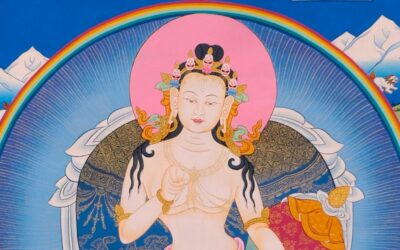The mountain is alive 2

Written By Paul Baffier
Blog | Culture and tradition | Reflections on life
In “The Mountain is Alive 2”, Paul speaks of the Yullha as deities-regions as well as protectors of living beings and spiritual teachings.
« The mountain is alive 2 »
Masters of the soil, masters of the spirits.
Ancient writings speak of four King Mountains in Tibet. Each is linked to an ancestral tradition, to a mythical figure who shaped Tibetan history: the kings, Padmasambhava, or the mythical king Gesar of Ling.
Nyanchen Thanglha is one of these sovereign mounts. It is said that when the Indian master Padmasambhava arrived in Tibet, Nyanchen Thanglha appeared in the form of an giant white snake and spread her rings over several regions of Tibet in an enormous display of power. Padmasambhava then entered into intense meditative absorption, deploying the power of the absolute nature of mind: Nyanchen Thanglha, in danger of perishing, submitted to the power of this concentration. He then transformed himself into a child dressed in white with a turquoise diadem, and offered the master the heart of his vital breath (tib.: srog snying, pronounced sognying). In return, Padmasambhava gave him an initiatory name and made him a sworn protector, in charge of guarding the teachings he would spread throughout Tibet.
Shortly afterwards, the protector changed into a man and went to meet Emperor Trisong Detsen, to whom he paid homage. Asked about his conduct, he explained that he and the emperor were connected in four different ways: they were protectors of the four regions of central Tibet, they were beings of great loyalty, they were beings of great humility, they possessed great merit. Padamsambhava ordered him to watch over the emperor’s lineage. Nyanchen then became the “koula” (sku lha/sku bla), the emperor’s vital guardian deity.
“They are the sovereigns of a geographically determined territory. Sovereign because they rule over the elements: they can change the weather, cause disasters or increase harvests by intensifying plant growth.”
This story is a good example of what a “yul lha” is: not just a “local deity”, but perhaps more like a “deity-region”. A genius loci, a “spirit of the place”… In our Western languages, we use many qualifiers to describe these elemental beings who are, as we still feel, “masters of the soil” in the lands where we live. As the story of Padmasambhava and Trisong Detsen shows, the “deity-regions” have complex, ambivalent, yet profound relationships with human beings. They are not assigned to a single function, but have a history of their own, a personal trajectory capable of spiritual evolution and reversal.
They are the sovereigns of a geographically determined territory. Sovereign because they rule over the elements: they can change the weather, cause disasters or increase harvests by intensifying plant growth.
Endowed with this territorial power, the “masters of the foundation” (gzhi bdag – popularized as “Souvereigns of the earth”) thus possess a kind of governance over the fate of beings who are born, residing, or merely passing through their territory. Territorial deities are thus seen as the protectors of the vitality and invulnerability of the land over which they rule, as well as the people, animals and spirits, both beneficial and harmful, that inhabit it. They are the guardians of health, good fortune, fame, prosperity, success, happiness, stability and strength. They have the power to enhance these vital qualities or to harm them: sometimes benevolent, sometimes terrible, they know the duality of moods that we human beings experience.
They take impressive forms when they manifest themselves physically: giant snakes, warriors on horseback in armor, young men in divine splendor, thunderbolts or jewel-bearers, theriomorphic humanoids, black giants with fiery eyes – it’s a whole world of the invisible, infinitely rich, yet less chaotic than it might seem at first glance, since it’s not devoid of logic, hierarchies and laws…
In fact, the Spirit Mountain also has a heart (a cave, for example), a vital center that contains its three principles: its vital breath (srog, pronounced sog), its spirit (sems, pronounced sèm) and its vital force (bla, pronounced la). Yogis come here to strengthen their meditative practice, for these chtonian sanctuaries possess a profound telluric quality. However, this living energy is fierce, and the yogi may face many obstacles and injuries if he does not tame it. The belly of the mountains is therefore a center of worship, a place of wild knowledge to be understood and integrated.
Often, the stories show the spirits of the place in all their ferocity, very reluctant to be conquered by man: they manifest torrential rains, snowstorms, lightning storms, their lakes boil over – our recent climatic events (floods, hailstorms and fires) can give us a glimpse of the destructive power of an angry mountain – and it takes all the power of meditative absorption of an accomplished spiritual practitioner to convince these powerful spirits to return to calm. Tibetan history is full of stories in which this living geography is not only tamed, but also understood through knowledge of the nature of mind. A source of inspiration?
It may seem that all this harkens back to primitive forms of religion based on meteorological superstition and blind fear. Nothing could be further from the truth.
Studying the historical evolution of Buddhism and Bön in Tibet, researchers (Bellezza, Namkhai Norbu, Nebesky-Wojkowitz…) show that this animistic knowledge predates the expansion of these two religions in the Land of the Snows, and that not only was it not erased like a useless old belief, but that it survived through the structuring and evolution of spiritual practices, being fully integrated, digested and remodelled.
In this respect, as in the story of Padmasambhava’s taming of Nyanchen Thanglha, each local deity has a secret name and is given a specific form with distinct attributes that highlight its qualities and activities; liturgies invoke it, propitiate it, and remind it of its obligations to protect the place and the communities of beings who live there. Thus, there are ritual practice texts that allow us to contact the Deity, in a codified protocol that always brings the practitioner’s mind back to the absolute dimension of the nature of spirit.
While it’s true that human requests are sometimes trivial, the fact remains that all concentration practice begins and ends with contact with the ultimate nature of reality, thus emphasizing the illusory nature of all requests.
The man or woman (lha pa or lha mo) then enters a trance, seized by superhuman strength, and begins to speak in a strange voice: the deity-region then utters a few prophetic comments, likely to help the community of the territory under his or her care.
Finally, the link between the local deity and human spiritual practice continues through the generations: just as Nyanchen Thanglha became the “tutelary deity” (sku bla) of Emperor Trisong Detsen, it is not uncommon for a “yul-lha” to become the protector of a family or clan (ris rgyud lha, pronounced rigyu lha)…sometimes even to be considered the ancestral deity (mes lha, pronounced mé lha). Extraordinary integration of the human being with his environment, seeing himself bound by bone and blood to a chthonian god-ancestor.
This series of articles is based on some essential reading:
The Cult of Pure Crystal Mountain: Popular Pilgrimage and Visionary Landscape in Southeast Tibet, Tony Huber
Divine Dyads, Ancient Civilization in Tibet, John Vincent Bellezza
Oracles and Demons of Tibet: The Cult and Iconography of the Tibetan Protective Deities, René Nebesky-Wojkowitz
More Posts
The ground of all Künshi
This article “The ground of all, Künshi” provide a better understanding of the essential words and concepts of Dzogchen.
The Four Testaments of the Vidyādharas
This article from Grégoire presents the" Four Testaments of the Vidyādharas", essential teachings from the early masters of Dzogchen.
The Story of the First Masters: Garab Dorje
“The Story of the First Masters: Garab Dorje” is the first article in a new category about the masters of the Dzogchen lineage.





